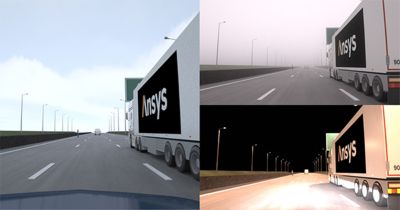-
United States -
United Kingdom -
India -
France -
Deutschland -
Italia -
日本 -
대한민국 -
中国 -
台灣
-
Ansys is committed to setting today's students up for success, by providing free simulation engineering software to students.
-
Ansys is committed to setting today's students up for success, by providing free simulation engineering software to students.
-
Ansys is committed to setting today's students up for success, by providing free simulation engineering software to students.
-
Contact Us -
Careers -
Students and Academic -
For United States and Canada
+1 844.462.6797
Ansys Blog
February 21, 2020
Focus Your Optical Design and Validation Workflows
Cameras are safety critical to the development of autonomous vehicles (AV) and advanced driver assistance systems (ADAS). Engineers need to ensure that these sensors operate in various environments while keeping up with the demands of the automotive market.
Simulation shows how an ADAS camera sees the world in clear daylight (left),
daylight fog (right, top) and night light (right, bottom)
As a result, engineers need a workflow that can quickly and accurately test, validate and iterate the sensor’s optical design.
Traditionally, these workflows have gotten bogged down by siloed data, intellectual property (IP) vulnerabilities and complexity. These challenges can slow the time to market, balloon budgets and hinder collaboration between suppliers and original equipment manufacturers (OEMs).
Alternatively, the Ansys Speos lens system importer, created in a partnership between Ansys and Zemax, is designed to streamline workflows and protect IP. This new end-to-end solution for camera testing and validation leverages the component-level design, modeling and simulation capabilities of Zemax’s OpticStudio® with the modeling, simulation, analysis and visualization benefits of Speos.
“Combining Ansys’ simulation portfolio with Zemax’s optical design tools will save automotive customers valuable time and resources,” said Eric Bantegnie, vice president and general manager at Ansys. “As we move towards a future of autonomous vehicles, drivers will benefit from efficient cameras that can identify hazards at night or in adverse weather conditions. This technology collaboration represents an important step forward for the industry.”
New Importer Streamlines the Workflows of Optical Designs
The Speos lens system importer can bring any camera lens design from Zemax’s industry-leading optical design software, OpticStudio, into Speos simulation software. Additionally, the system can be transferred as a black box, so IP is protected without limiting the simulation analysis.
How the Ansys Speos lens system importer works with Zemax’s OpticStudio®
Konrad Rothenhäusler, design for Six Sigma Coach, ADAS business unit at Continental, said, “Ansys offers the automated execution of simulation plans to solve complex problems in the design of autonomous vehicles. The end-to-end optical testing solution from Ansys and Zemax enables us to exchange optical transfer functions – which determines the quality of the projected image – while protecting our sensitive design data. This workflow will empower our team to explore new camera designs faster, cheaper and with less risk.”
The Speos lens system importer workflow reduces camera perception simulation time from hours to minutes while also protecting lens supplier IP throughout the workflow.
S. Subbiah, CEO of Zemax, said, “Optical technology is driving autonomous vehicle innovation by providing the all-round visibility that enables the car to react to its environment. But the successful development of these sensors is increasingly competitive as costs continue to rise and timelines shrink. Our collaboration with Ansys bridges the gap between optical and mechanical engineers as they explore sensor designs.”
Any and all ANSYS, Inc. brand, product, service and feature names, logos and slogans such as Ansys, Ansys Speos and Ansys VRXPERIENCE are registered trademarks or trademarks of ANSYS, Inc. or its subsidiaries in the United States or other countries.













